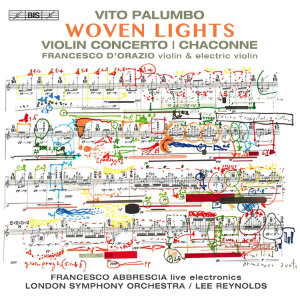
Vito Palumbo (b.1972)
Woven Lights
Violin Concerto (2015)
Chaconne (2019-20)
Francesco D’Orazio (violin; electric violin)
Francesco Abbrescia (live electronics)
London Symphony Orchestra/Lee Reynolds
rec. 2016/21; Bari, Italy; London
BIS BIS-2625 [58]
Here are two half hour works by Italian composer Vito Palumbo who is in his early fifties. Having studied in Siena and at Rome’s Academy of Santa Cecilia in Rome his CV is distinguished by awards, offices, concerts, broadcasts, premieres and the trappings of creative success. His worklist includes landmark concertos for clarinet, recorder, cello and harpsichord. He has an interest in astronomy and this can I think be heard in Bis’s music. The individual has a voice but paradoxically it is made the more telling by being dwarfed by the limitless expanses of space and time. The composer recounts that ‘I want the meaning of my music to be apparent from listening, without the need for verbal justification.’
Of the two scores the first is a Concerto for violin and orchestra. This is in a single-tracked
30-minute movement. A solution of tense foreboding and beetling catastrophe are the order of the day. The violin evokes thoughts of Ifrits rising like evocations of flame and driven upwards by superheated thermals. Palumbo embraces some ferociously stropped violent dissonance but weaves in a romantic style: Walton/Berg. It is as if a sky-soaring Ariel is gripped by a mystical pilgrimage. There are moments of appeasing calm (8.40), hesitant wispy writing deep in the undergrowth (18.11). Pizzicati and precipitous slides recall Hovhaness with the solo instrument slipping frictionless and free. (28.00). All ends in silence. This work will appeal to those who warm to the Violin Concerto by Missy Mazzoli – also on Bis.
A change of instrumental cams and gears comes with the other work: a Chaconne for five-stringed electric violin and electronics (2019-20). There’s no orchestra this time. The music is in two substantial movements: Woven Lights and The Glows in the Dark. The first of these has the soloist juxtaposed with sampled sounds and electronics. The second has D’Orazio’s solo plus 30 pre-recorded electric violin parts. Like the more conventionally scored Concerto this work is intricate and delicate: a jangling and twangling Prospero’s Island. It’s another impressively virtuoso piece – a thing of wonder. That said it has so far struggled to gain any purchase on my emotions. This is especially true of the second part. D’Orazio is dedicatee of the Chaconne.
As is BIS’s practice these days, the CD comes with a supportive essay and other written material. It’s all in a cleverly contrived card sleeve. This is also notable for an extra paper inner sleeve for a disc that thereby avoids any potentially abrasive contact with the card.
Rob Barnett
Help us financially by purchasing from





















